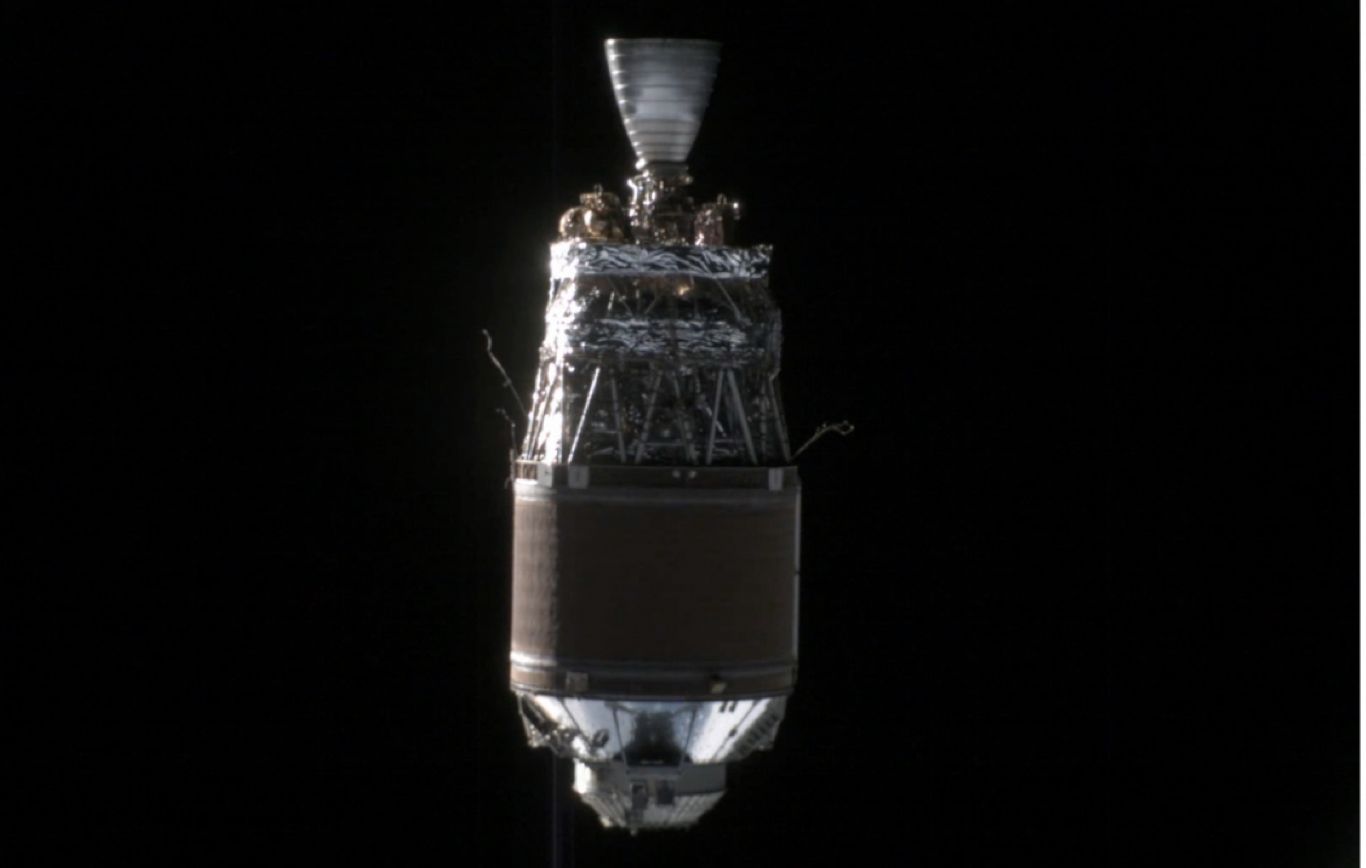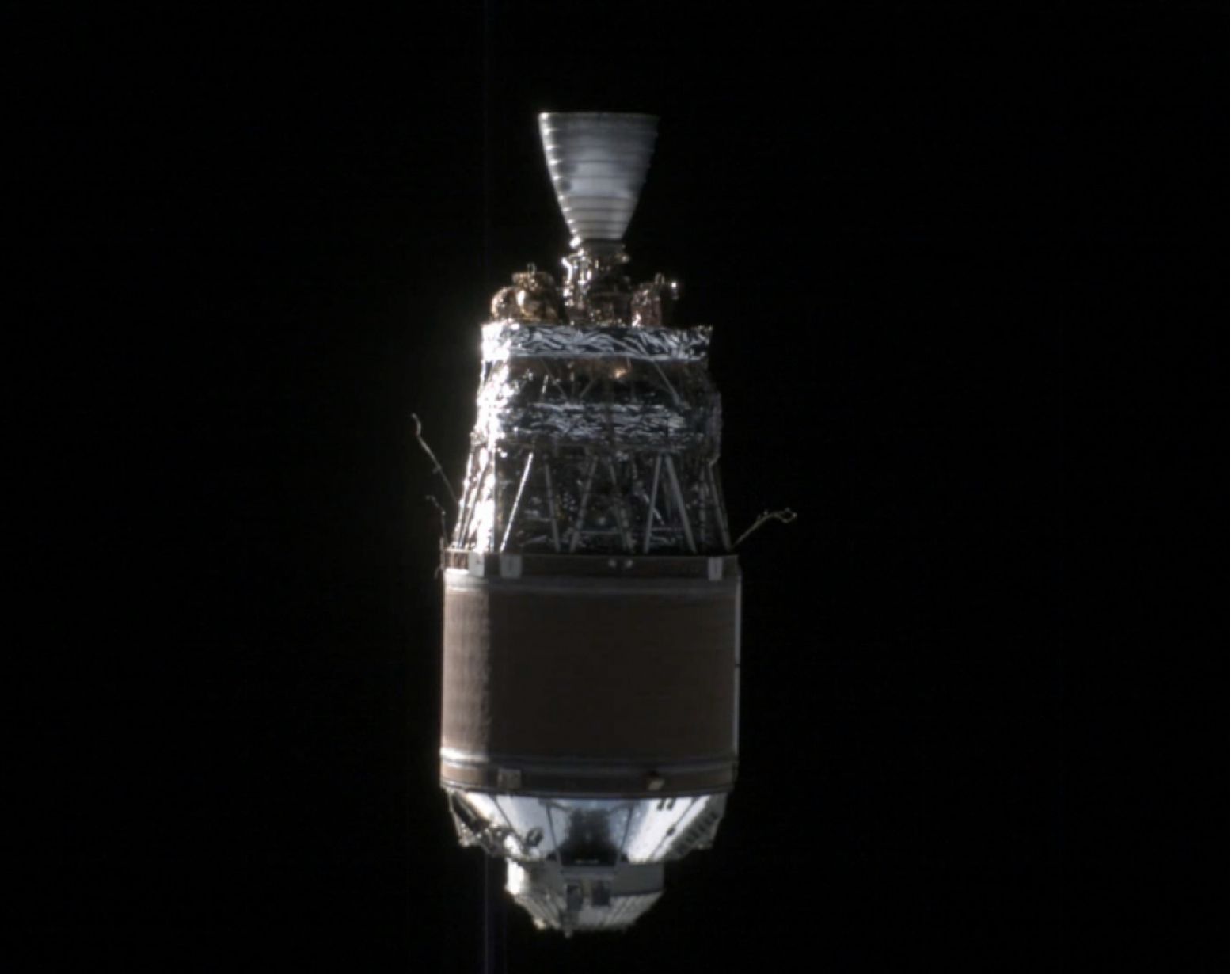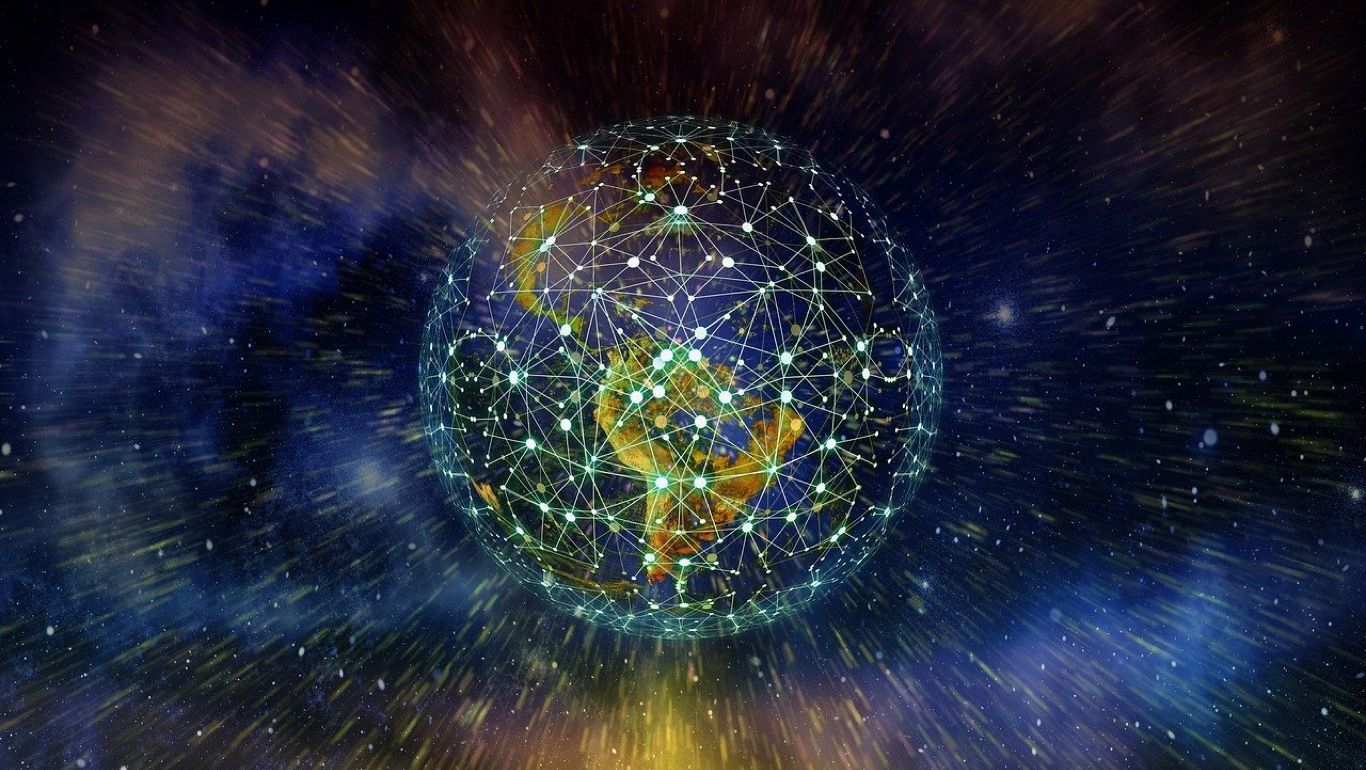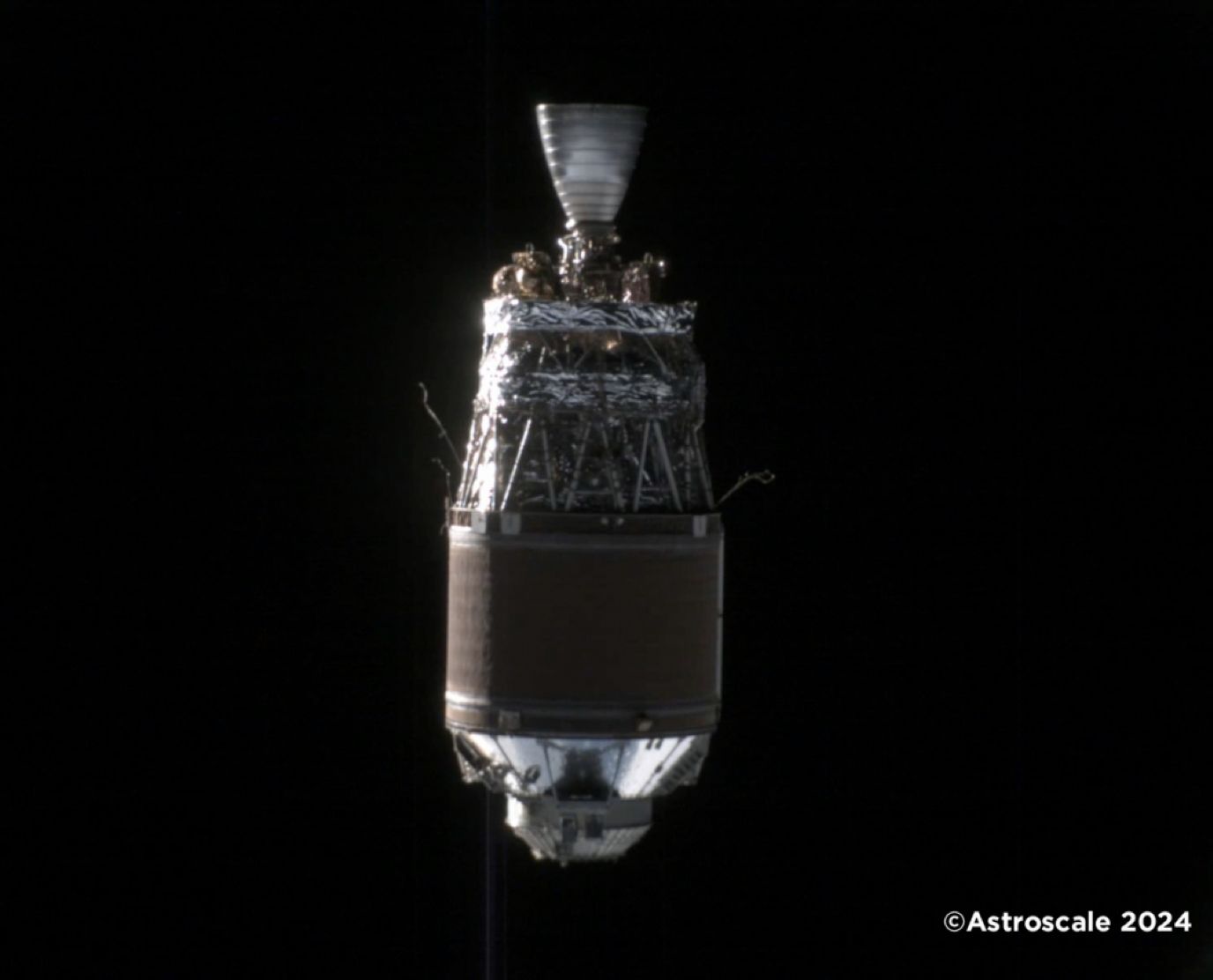Define Our Future
06 July 2024

(ADRAS-J takes image of debris from just 50 metres (Image: Astroscale)
Last month, the commercial orbital sustainability company Astroscale (Japan) published its second close-up photograph of a significant piece of space debris: a Japanese H-2A second-stage rocket, initially discarded in 2009. This image was captured as part of their Active Debris Removal by Astroscale-Japan (ADRAS-J) mission, which involves a close proximity approach to collect data and inform future debris removal efforts.
Astroscale is a global leader in the burgeoning commercial debris management sector, highlighting the growing awareness of space sustainability and the necessity of preserving space for future generations. However, while these initiatives are crucial, they are still in the technology validation stages. Even with proven technology, the challenge of cleaning up Earth's orbit and mitigating debris collision risks remains daunting. The European Space Agency (ESA) estimates there are 36,500 pieces of large debris and 130 million pieces of tiny space debris in orbit, with the problem escalating.
As of May 2024, there were 9,900 active satellites in orbit, with 84% in low Earth orbit (LEO) at altitudes of 500-1000 km. Much of this space is occupied by rapidly expanding mega-constellations such as Starlink, which now accounts for more than half of all active satellites (6,673). SpaceX aims to expand Starlink to 42,000 satellites, providing global high-speed broadband access. Rival mega-constellations from three Chinese entities and Amazon's Kuiper constellation will further increase this number, with projections of over 100,000 active satellites by the decade's end.
Satellite owners are required to decommission retired and defunct vehicles, and last year, the US FCC issued its first-ever fine for non-compliance. However, this precedent does not address the growing congestion in Earth's orbit and the increasing risks of debris collisions. Every collision creates hundreds of smaller debris pieces, exacerbating the problem. For instance, a Russian satellite breakup on June 26 created numerous debris pieces, prompting ISS astronauts to take cover. LeoLabs, an orbital observation company, is now tracking around 180 objects from this event.
ESA’s Zero Debris Charter and Sustainable Space Business Models
ESA is a key player in mitigating space debris, establishing its "Zero Debris Charter" this year, aiming to make Europe debris-neutral by 2030. In May, 12 nations, including Germany, the UK, and Sweden, each with ambitious sovereign New Space launch capabilities, singed-on to the charter.
Recently, three European companies signed contracts with ESA to develop satellites under the Zero Debris commitment. Airbus Defence and Space, Thales Alenia Space, and OHB will develop LEO satellites adhering to the charter's sustainability standards.
UK-based 3S Northumbria, a signatory of the charter, is integrating the initiative into its activities. According to Innovation News Network, 3S Northumbria plans to take sustainable initiatives further, suggesting the charter "should herald a multifaceted, internationally coordinated drive towards a broader circular economy for outer space activities." A circular economy aims to recycle, reuse, and repurpose waste materials for as long as possible. 3S Northumbria will explore how this model can be applied in space, promoting strategies that connect existing sustainability efforts with circular economy principles.
Sustainability initiatives are increasingly becoming central to business models in the rapidly expanding space sector, as more nations seek the benefits of downstream space services.
At the recent UN Committee on Peaceful Uses of Outer Space annual meeting, Space Renaissance International (SRI), a non-profit organisation, was granted observer status for three years. SRI, which emphasises sustainability, may use its status to promote the role of space in achieving the UN Sustainable Development Goals (SDGs) and advocate for a new SDG focused on space sustainability.

(Image: Pixabay)
Blockchain and Decentralized Governance in Space
Innovative tech solutions could help build a regulatory environment for a sustainable future in space. Space policy is currently a significant agenda item, with a need for new rules and norms and clear gaps in existing frameworks.
The Global Symposium for Regulators, hosted by the UN International Telecommunications Union, will this year discuss the space regulatory environment and consider "measures and approaches for an inclusive, safe, and sustainable space economy," according to Cosmas Luckyson Zavazava, director of the ITU's telecommunications development division.
One potential solution for managing space objects and mitigating debris is blockchain technology. A decentralised ledger can log debris positions and characteristics, and blockchain's transparent nature ensures tamper-proof data. Smart contracts could increase efficiency in debris removal, and token-based incentives could reward companies for debris removal efforts.
Blockchain could also enhance space supply chain management systems, ensuring traceability of components. Additionally, in discussions about fair resource use in space (such as on the Moon), blockchain could transparently monitor resource allocation, potentially reducing geopolitical conflicts.
Decentralized Autonomous Organizations for Space Governance
Proposals for using blockchain in governance systems are also emerging. The central piece of outer space law, the UN Outer Space Treaty (1967), is outdated, lacking rules for commercial activity and resource exploitation.
Efforts to resolve these issues have are slow to develop due to geopolitical rivalries, strained international relations, and a lack of trust. The US and China are engaged in a lunar race, with each side wary of the other's intentions. Both nations have proposed frameworks for space regulation—the US Artemis Accords and China's International Lunar Research Station (ILRS) project—but neither side is willing to join the other's initiative.
A trustless system like blockchain could overcome these hurdles. The United Nations Internet Governance Forum (IGF) announced a pilot program using a Distributed Autonomous Organization (DAO) at the end of 2023. In a DAO, decision-making and governance processes are encoded into smart contracts on a blockchain, allowing members to participate without traditional hierarchical structures. All transactions are logged on a transparent blockchain ledger, and digital tokens enable voting rights.
MoonDAO, an organisation using a DAO, aims to establish a decentralised "multi-planetary future with an open platform," with plans to build a lunar colony by 2030. Although ambitious, this technology could facilitate trustless processes, enable cooperative lunar projects, and reduce the risk of a lunar race.
Define Our Future

ADRAS-J takes image of debris from just 50 metres (Image: Astroscale)
06 July 2024
Zero Debris Charter, Sustainable Business Models For Space, Applications For Blockchain in Governance - Space News Roundup

Last month, the commercial orbital sustainability company Astroscale (Japan) published its second close-up photograph of a significant piece of space debris: a Japanese H-2A second-stage rocket, initially discarded in 2009. This image was captured as part of their Active Debris Removal by Astroscale-Japan (ADRAS-J) mission, which involves a close proximity approach to collect data and inform future debris removal efforts.
Astroscale is a global leader in the burgeoning commercial debris management sector, highlighting the growing awareness of space sustainability and the necessity of preserving space for future generations. However, while these initiatives are crucial, they are still in the technology validation stages. Even with proven technology, the challenge of cleaning up Earth's orbit and mitigating debris collision risks remains daunting. The European Space Agency (ESA) estimates there are 36,500 pieces of large debris and 130 million pieces of tiny space debris in orbit, with the problem escalating.
As of May 2024, there were 9,900 active satellites in orbit, with 84% in low Earth orbit (LEO) at altitudes of 500-1000 km. Much of this space is occupied by rapidly expanding mega-constellations such as Starlink, which now accounts for more than half of all active satellites (6,673). SpaceX aims to expand Starlink to 42,000 satellites, providing global high-speed broadband access. Rival mega-constellations from three Chinese entities and Amazon's Kuiper constellation will further increase this number, with projections of over 100,000 active satellites by the decade's end.
Satellite owners are required to decommission retired and defunct vehicles, and last year, the US FCC issued its first-ever fine for non-compliance. However, this precedent does not address the growing congestion in Earth's orbit and the increasing risks of debris collisions. Every collision creates hundreds of smaller debris pieces, exacerbating the problem. For instance, a Russian satellite breakup on June 26 created numerous debris pieces, prompting ISS astronauts to take cover. LeoLabs, an orbital observation company, is now tracking around 180 objects from this event.
ESA’s Zero Debris Charter and Sustainable Space Business Models
ESA is a key player in mitigating space debris, establishing its "Zero Debris Charter" this year, aiming to make Europe debris-neutral by 2030. In May, 12 nations, including Germany, the UK, and Sweden, each with ambitious sovereign New Space launch capabilities, singed-on to the charter.
Recently, three European companies signed contracts with ESA to develop satellites under the Zero Debris commitment. Airbus Defence and Space, Thales Alenia Space, and OHB will develop LEO satellites adhering to the charter's sustainability standards.
UK-based 3S Northumbria, a signatory of the charter, is integrating the initiative into its activities. According to Innovation News Network, 3S Northumbria plans to take sustainable initiatives further, suggesting the charter "should herald a multifaceted, internationally coordinated drive towards a broader circular economy for outer space activities." A circular economy aims to recycle, reuse, and repurpose waste materials for as long as possible. 3S Northumbria will explore how this model can be applied in space, promoting strategies that connect existing sustainability efforts with circular economy principles.
Sustainability initiatives are increasingly becoming central to business models in the rapidly expanding space sector, as more nations seek the benefits of downstream space services.
At the recent UN Committee on Peaceful Uses of Outer Space annual meeting, Space Renaissance International (SRI), a non-profit organisation, was granted observer status for three years. SRI, which emphasises sustainability, may use its status to promote the role of space in achieving the UN Sustainable Development Goals (SDGs) and advocate for a new SDG focused on space sustainability.

(Image: Pixabay)
Blockchain and Decentralized Governance in Space
Innovative tech solutions could help build a regulatory environment for a sustainable future in space. Space policy is currently a significant agenda item, with a need for new rules and norms and clear gaps in existing frameworks.
The Global Symposium for Regulators, hosted by the UN International Telecommunications Union, will this year discuss the space regulatory environment and consider "measures and approaches for an inclusive, safe, and sustainable space economy," according to Cosmas Luckyson Zavazava, director of the ITU's telecommunications development division.
One potential solution for managing space objects and mitigating debris is blockchain technology. A decentralised ledger can log debris positions and characteristics, and blockchain's transparent nature ensures tamper-proof data. Smart contracts could increase efficiency in debris removal, and token-based incentives could reward companies for debris removal efforts.
Blockchain could also enhance space supply chain management systems, ensuring traceability of components. Additionally, in discussions about fair resource use in space (such as on the Moon), blockchain could transparently monitor resource allocation, potentially reducing geopolitical conflicts.
Decentralized Autonomous Organizations for Space Governance
Proposals for using blockchain in governance systems are also emerging. The central piece of outer space law, the UN Outer Space Treaty (1967), is outdated, lacking rules for commercial activity and resource exploitation.
Efforts to resolve these issues have are slow to develop due to geopolitical rivalries, strained international relations, and a lack of trust. The US and China are engaged in a lunar race, with each side wary of the other's intentions. Both nations have proposed frameworks for space regulation—the US Artemis Accords and China's International Lunar Research Station (ILRS) project—but neither side is willing to join the other's initiative.
A trustless system like blockchain could overcome these hurdles. The United Nations Internet Governance Forum (IGF) announced a pilot program using a Distributed Autonomous Organization (DAO) at the end of 2023. In a DAO, decision-making and governance processes are encoded into smart contracts on a blockchain, allowing members to participate without traditional hierarchical structures. All transactions are logged on a transparent blockchain ledger, and digital tokens enable voting rights.
MoonDAO, an organisation using a DAO, aims to establish a decentralised "multi-planetary future with an open platform," with plans to build a lunar colony by 2030. Although ambitious, this technology could facilitate trustless processes, enable cooperative lunar projects, and reduce the risk of a lunar race.
Share this article
06 July 2024
Zero Debris Charter, Sustainable Business Models For Space, Applications For Blockchain in Governance - Space News Roundup


ADRAS-J takes image of debris from just 50 metres (Image: Astroscale)
Last month, the commercial orbital sustainability company Astroscale (Japan) published its second close-up photograph of a significant piece of space debris: a Japanese H-2A second-stage rocket, initially discarded in 2009. This image was captured as part of their Active Debris Removal by Astroscale-Japan (ADRAS-J) mission, which involves a close proximity approach to collect data and inform future debris removal efforts.
Astroscale is a global leader in the burgeoning commercial debris management sector, highlighting the growing awareness of space sustainability and the necessity of preserving space for future generations. However, while these initiatives are crucial, they are still in the technology validation stages. Even with proven technology, the challenge of cleaning up Earth's orbit and mitigating debris collision risks remains daunting. The European Space Agency (ESA) estimates there are 36,500 pieces of large debris and 130 million pieces of tiny space debris in orbit, with the problem escalating.
As of May 2024, there were 9,900 active satellites in orbit, with 84% in low Earth orbit (LEO) at altitudes of 500-1000 km. Much of this space is occupied by rapidly expanding mega-constellations such as Starlink, which now accounts for more than half of all active satellites (6,673). SpaceX aims to expand Starlink to 42,000 satellites, providing global high-speed broadband access. Rival mega-constellations from three Chinese entities and Amazon's Kuiper constellation will further increase this number, with projections of over 100,000 active satellites by the decade's end.
Satellite owners are required to decommission retired and defunct vehicles, and last year, the US FCC issued its first-ever fine for non-compliance. However, this precedent does not address the growing congestion in Earth's orbit and the increasing risks of debris collisions. Every collision creates hundreds of smaller debris pieces, exacerbating the problem. For instance, a Russian satellite breakup on June 26 created numerous debris pieces, prompting ISS astronauts to take cover. LeoLabs, an orbital observation company, is now tracking around 180 objects from this event.
ESA’s Zero Debris Charter and Sustainable Space Business Models
ESA is a key player in mitigating space debris, establishing its "Zero Debris Charter" this year, aiming to make Europe debris-neutral by 2030. In May, 12 nations, including Germany, the UK, and Sweden, each with ambitious sovereign New Space launch capabilities, singed-on to the charter.
Recently, three European companies signed contracts with ESA to develop satellites under the Zero Debris commitment. Airbus Defence and Space, Thales Alenia Space, and OHB will develop LEO satellites adhering to the charter's sustainability standards.
UK-based 3S Northumbria, a signatory of the charter, is integrating the initiative into its activities. According to Innovation News Network, 3S Northumbria plans to take sustainable initiatives further, suggesting the charter "should herald a multifaceted, internationally coordinated drive towards a broader circular economy for outer space activities." A circular economy aims to recycle, reuse, and repurpose waste materials for as long as possible. 3S Northumbria will explore how this model can be applied in space, promoting strategies that connect existing sustainability efforts with circular economy principles.
Sustainability initiatives are increasingly becoming central to business models in the rapidly expanding space sector, as more nations seek the benefits of downstream space services.
At the recent UN Committee on Peaceful Uses of Outer Space annual meeting, Space Renaissance International (SRI), a non-profit organisation, was granted observer status for three years. SRI, which emphasises sustainability, may use its status to promote the role of space in achieving the UN Sustainable Development Goals (SDGs) and advocate for a new SDG focused on space sustainability.

(Image: Pixabay)
Blockchain and Decentralized Governance in Space
Innovative tech solutions could help build a regulatory environment for a sustainable future in space. Space policy is currently a significant agenda item, with a need for new rules and norms and clear gaps in existing frameworks.
The Global Symposium for Regulators, hosted by the UN International Telecommunications Union, will this year discuss the space regulatory environment and consider "measures and approaches for an inclusive, safe, and sustainable space economy," according to Cosmas Luckyson Zavazava, director of the ITU's telecommunications development division.
One potential solution for managing space objects and mitigating debris is blockchain technology. A decentralised ledger can log debris positions and characteristics, and blockchain's transparent nature ensures tamper-proof data. Smart contracts could increase efficiency in debris removal, and token-based incentives could reward companies for debris removal efforts.
Blockchain could also enhance space supply chain management systems, ensuring traceability of components. Additionally, in discussions about fair resource use in space (such as on the Moon), blockchain could transparently monitor resource allocation, potentially reducing geopolitical conflicts.
Decentralised Autonomous Organisations for Space Governance
Proposals for using blockchain in governance systems are also emerging. The central piece of outer space law, the UN Outer Space Treaty (1967), is outdated, lacking rules for commercial activity and resource exploitation.
Efforts to resolve these issues have are slow to develop due to geopolitical rivalries, strained international relations, and a lack of trust. The US and China are engaged in a lunar race, with each side wary of the other's intentions. Both nations have proposed frameworks for space regulation—the US Artemis Accords and China's International Lunar Research Station (ILRS) project—but neither side is willing to join the other's initiative.
A trustless system like blockchain could overcome these hurdles. The United Nations Internet Governance Forum (IGF) announced a pilot program using a Distributed Autonomous Organization (DAO) at the end of 2023. In a DAO, decision-making and governance processes are encoded into smart contracts on a blockchain, allowing members to participate without traditional hierarchical structures. All transactions are logged on a transparent blockchain ledger, and digital tokens enable voting rights.
MoonDAO, an organisation using a DAO, aims to establish a decentralised "multi-planetary future with an open platform," with plans to build a lunar colony by 2030. Although ambitious, this technology could facilitate trustless processes, enable cooperative lunar projects, and reduce the risk of a lunar race.
Share this article

